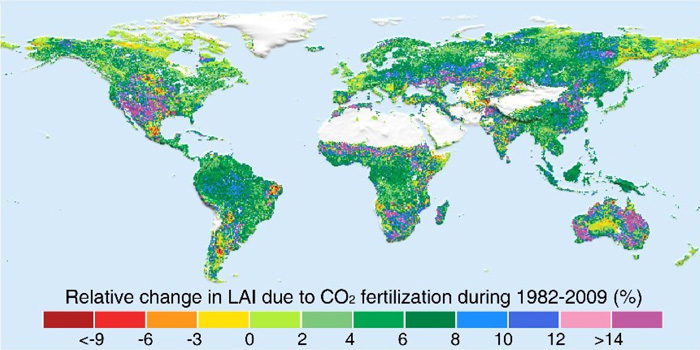Climate Models Fail Again, Didn’t Predict CO2 Would Green The Western US

Figure S12, Zhu et al. (2016)

Figure S12, Zhu et al. (2016)
From a quarter to half of Earth's vegetated lands has shown significant greening over the last 35 years largely due to rising levels of atmospheric carbon dioxide, according to a new study published in the journal Nature Climate Change on April 25. An international team of 32 authors from 24 institutions in eight countries led the effort, which involved using satellite data from NASA's Moderate Resolution Imaging Spectrometer and the National Oceanic and Atmospheric Administration's Advanced Very High Resolution Radiometer instruments to help determine the leaf area index, or amount of leaf cover, over the planet's vegetated regions. The greening represents an increase in leaves on plants and trees equivalent in area to two times the continental United States. --NASA, 26 April 2016
Among the many climate-alarmist fears of CO2-induced global warming is the concern that the productivity of the biosphere will decline if global temperatures rise to the extent predicted by computer models. So just how bad is the biosphere suffering in response to these much-feared events? A new paper by Zhu et al. (2016) provides valuable insight into this important topic. 32 researchers -- representing 9 different countries -- report finding "a persistent and widespread increase of growing season integrated LAI (greening) over 25% to 50% of the global vegetated area, whereas less than 4% of the globe shows decreasing LAI (browning)." Could one hope for anything more promising than this? Quite the opposite of what the world's climate alarmists contend should be happening to Earth's vegetation, rising atmospheric CO2 enrichment is proving to be a tremendous biospheric benefit, overpowering the many real and negative influences that society and nature have inflicted upon it over the past three decades. --CO2 Science, 26 April 2016
Empirical data conï¬rms that the biosphere’s productivity has increased by about 14% since 1982, in large part as a result of rising carbon dioxide levels. It is very likely that the impact of rising carbon dioxide concentrations is currently net beneï¬cial for both humanity and the biosphere generally. These beneï¬ts are real, whereas the costs of warming are uncertain. Halting the increase in carbon dioxide concentrations abruptly would deprive people and the planet of the beneï¬ts of carbon dioxide much sooner than they would reduce any costs of warming. --Indur Goklany, Global Warming Policy Foundation, October 2015
Several analyses have been conducted to estimate potential monetary damages of the rising atmospheric CO2 concentration. Few, however, have attempted to investigate its monetary benefits. The present study addresses this deficiency by providing a quantitative estimate of the direct monetary benefits conferred by atmospheric CO2 enrichment on both historic and future global crop production. The results indicate that the annual total monetary value of this benefit grew from $18.5 billion in 1961 to over $140 billion by 2011, amounting to a total sum of $3.2 trillion over the 50-year period 1961-2011. Projecting the monetary value of this positive externality forward in time reveals it will likely bestow an additional $9.8 trillion on crop production between now and 2050. -- Craig D. Idso, CO2 Science, October 2013
Roger Harrabin (BBC): Do you think that somebody who benefits from the burning of CO2 should take responsibility for the waste product which is the CO2 that is unwanted, in the same way that a chemicals firm who used raw materials would have to take responsibility for the waste effluent into the water, for instance, would that be a reasonable position?
Benny Peiser: I think it would actually be a reasonable position under the condition that the same company could also get the benefits of their product, so yes, they should pay for the negative externalities, but they should also get paid for the benefits of the positive externalities. I think in that case it would make sense. Just to make them pay for the negative consequences, disregarding the positive benefits they bring, I think would be a one sided thing, unlikely to be adopted by any government. --Open University, November 2015
Climate scientists and environmentalists have claimed for years droughts and heatwaves were getting worse because of man-made global warming, but those predictions have not come true, according to a new study. “Evidence that droughts have become more prevalent on a global scale is equally hard to come by,” Andrew Montford, a British author and global warming skeptic, wrote in a new report published by the Global Warming Policy Foundation. Montford’s report debunks many claims advanced by activists that droughts and heatwaves were getting worse, citing examples of alarmism playing out across the world and costing taxpayers billions of dollars. --Michael Bastasch, The Daily Caller, 25 April 2016
Brought to you by Benny Peiser's Global Warming Policy Forum
No comments:
Post a Comment